Some of you might know that Wally (a moderator here and fellow community member) is currently on a trip through Europe.
Yesterday, he was in Munich and therefore not far away from me and Global Components.
Well, and as Nikolaus received the new PCBs a couple of days ago and finished doing quick tests with them, I took the opportunity to meet up with Wally and his girlfriend at Global Components so they can get a tour of the factory and also meet up with Nikolaus to pick up the new PCBs - the final revision!
So yep, we got a couple of new mainboards including the new 4GB RAM CPU boards now:
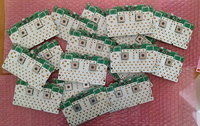
These little buggers have cost 25,000 EUR just to produce them... yep, developing and producing something like the Pyra is pretty expensive!
Are they working? Have all the bugs been fixed?
Well, it's impossible to tell whether all the bugs have been fixed. All KNOWN bugs have been fixed - but there can always be well hidden ones, like with any other device out there, be it smartphone, washing machine or whatever.
But yes, there shouldn't be any obvious showstopper now.
Nikolaus has already tested whether the issues we found with the last revision have been fixed - and they are.
The sad news: The wonky chip is no more there as you know it.
The good news: The area is now full of wonky parts
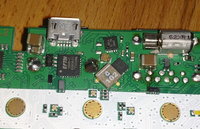
No more sirring noises, USB is now working as expected, holding a shoulder button while switching on the system no longer stops the unit from booting... well, and all other things we found are now fine as well.
While Wifi has not been thoroughly tested (see further down), a quick test showed promising results.
Here are the new Wifi antennas:
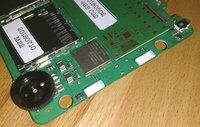
So what we have here is most likely (99,9% sure) the final revision of the PCBs!
Here are some pictures of the whole PCBs:
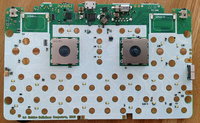
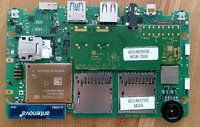
What's left to do?
Thoroughly test the PCBs in order to prepare for Mass production
Nikolaus did a quick test of the PCBs. All except one or two are booting into the console without any issues, which is a good start.
However, we now need to more thoroughly test them. All sensors, connectors, functions, etc. need to be tested and reported back to Global Components, so they can check the issues and make sure to keep the failure rate as low as possible for the mass production.
That's what I'll be working on within the next few weeks.
I'll also assemble more units and send them to developers to help out as well as the ones who ordered a prototype (once they are tested).
Optimize the resistance value for Wifi
We've improved the antennas and the traces on the PCB have been optimized for our Wifi Antennas as well.
This should give us a very good Wifi reception already, but it can be further tweaked and improved with proper measurement devices.
We've got a company who will do that. For the exact resistance measurement of the PCB traces, we've added the following testing area for them:

So if you ever open up your Pyra and wonder what this is: Now you know
A new hardware revision will NOT be needed after their measurements.
These improvements will be small resistance changes which will be done using resistors on the PCB.
So the only things that could change are resistor values of already existing resistors on the PCB. No layout or hardware change.
CE-/ FCC-Testing and certification
As we now have the final unit, it's time to do the CE/FCC-Tests.
The lab has been booked for August 8th.
On that day, I'll do the final CE Certification of the Colecovision USB Power Plug (you can find details about that here in case you haven't heard of it) and also a pre-testing of the Pyra.
Why only a pretesting? Well, a full CE test does cost around 2000 EUR (as you need to book the lab for a full day)
And once you booked the lab for a day, you need to pay for it.
The Pyra is a complex device - so it could be it needs some additional shielding, etc. to pass the CE.
In that case, it's enough to book the lab for 2 - 3 hours and check for any issues - that's a lot safer and cheaper.
If no issues occur, we can book the full CE test.
If issues occur, we know exactly where, can fix them (and check them without needing the lab) and then book the full CE test.
So let's hope no CE issues occur on August 8th
Basically, that's all that's left to do.
(well, hardwarewise, of course. Software will constantly being worked on).
It's also time to arrange the mass production... order all needed parts (for cooling, packaging, etc.)
But yep, it looks we're done now. Finally!
Please don't expect that we'll start shipping in a month or so (it will always take two months )
)
Preparation, receiving all the needed parts, etc. always takes some time as well.
But there's no turning back now
Ah, I got some more pictures for you. A fully assembled unit. If you visit the GamesCom, this is what you will be able to test out!
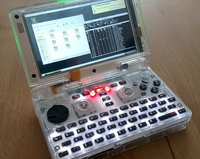
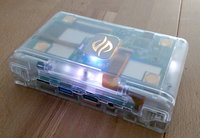
Here you can see the aluminium plate to cool and shield the battery from the heat as well as the heatsink hidden below the USB port:
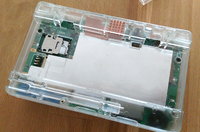
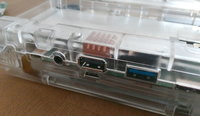
So much for todays newspost
Feel free to post any questions if you have them.
However, don't forget I'll have a live video stream soon as well where you can ask questions live
More on that later today.
Yesterday, he was in Munich and therefore not far away from me and Global Components.
Well, and as Nikolaus received the new PCBs a couple of days ago and finished doing quick tests with them, I took the opportunity to meet up with Wally and his girlfriend at Global Components so they can get a tour of the factory and also meet up with Nikolaus to pick up the new PCBs - the final revision!
So yep, we got a couple of new mainboards including the new 4GB RAM CPU boards now:

These little buggers have cost 25,000 EUR just to produce them... yep, developing and producing something like the Pyra is pretty expensive!
Are they working? Have all the bugs been fixed?
Well, it's impossible to tell whether all the bugs have been fixed. All KNOWN bugs have been fixed - but there can always be well hidden ones, like with any other device out there, be it smartphone, washing machine or whatever.
But yes, there shouldn't be any obvious showstopper now.
Nikolaus has already tested whether the issues we found with the last revision have been fixed - and they are.
The sad news: The wonky chip is no more there as you know it.
The good news: The area is now full of wonky parts

No more sirring noises, USB is now working as expected, holding a shoulder button while switching on the system no longer stops the unit from booting... well, and all other things we found are now fine as well.
While Wifi has not been thoroughly tested (see further down), a quick test showed promising results.
Here are the new Wifi antennas:

So what we have here is most likely (99,9% sure) the final revision of the PCBs!
Here are some pictures of the whole PCBs:


What's left to do?
Thoroughly test the PCBs in order to prepare for Mass production
Nikolaus did a quick test of the PCBs. All except one or two are booting into the console without any issues, which is a good start.
However, we now need to more thoroughly test them. All sensors, connectors, functions, etc. need to be tested and reported back to Global Components, so they can check the issues and make sure to keep the failure rate as low as possible for the mass production.
That's what I'll be working on within the next few weeks.
I'll also assemble more units and send them to developers to help out as well as the ones who ordered a prototype (once they are tested).
Optimize the resistance value for Wifi
We've improved the antennas and the traces on the PCB have been optimized for our Wifi Antennas as well.
This should give us a very good Wifi reception already, but it can be further tweaked and improved with proper measurement devices.
We've got a company who will do that. For the exact resistance measurement of the PCB traces, we've added the following testing area for them:

So if you ever open up your Pyra and wonder what this is: Now you know
A new hardware revision will NOT be needed after their measurements.
These improvements will be small resistance changes which will be done using resistors on the PCB.
So the only things that could change are resistor values of already existing resistors on the PCB. No layout or hardware change.
CE-/ FCC-Testing and certification
As we now have the final unit, it's time to do the CE/FCC-Tests.
The lab has been booked for August 8th.
On that day, I'll do the final CE Certification of the Colecovision USB Power Plug (you can find details about that here in case you haven't heard of it) and also a pre-testing of the Pyra.
Why only a pretesting? Well, a full CE test does cost around 2000 EUR (as you need to book the lab for a full day)
And once you booked the lab for a day, you need to pay for it.
The Pyra is a complex device - so it could be it needs some additional shielding, etc. to pass the CE.
In that case, it's enough to book the lab for 2 - 3 hours and check for any issues - that's a lot safer and cheaper.
If no issues occur, we can book the full CE test.
If issues occur, we know exactly where, can fix them (and check them without needing the lab) and then book the full CE test.
So let's hope no CE issues occur on August 8th
Basically, that's all that's left to do.
(well, hardwarewise, of course. Software will constantly being worked on).
It's also time to arrange the mass production... order all needed parts (for cooling, packaging, etc.)
But yep, it looks we're done now. Finally!
Please don't expect that we'll start shipping in a month or so (it will always take two months
Preparation, receiving all the needed parts, etc. always takes some time as well.
But there's no turning back now
Ah, I got some more pictures for you. A fully assembled unit. If you visit the GamesCom, this is what you will be able to test out!


Here you can see the aluminium plate to cool and shield the battery from the heat as well as the heatsink hidden below the USB port:


So much for todays newspost
Feel free to post any questions if you have them.
However, don't forget I'll have a live video stream soon as well where you can ask questions live
More on that later today.

